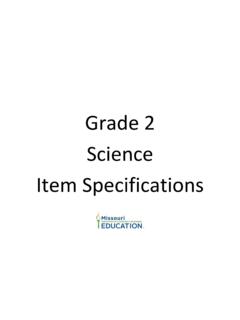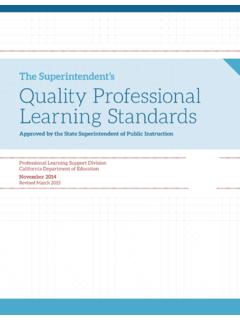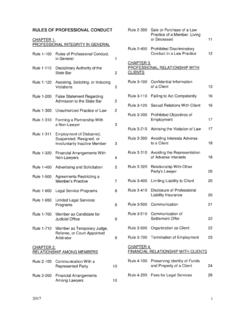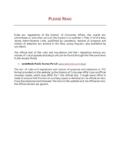Transcription of Using Professional Artifacts in Evaluations
1 Using Professional Artifacts in EvaluationsMISSOURI DEPARTMENT OF ELEMENTARY AND SECONDARY EDUCATION 2014 Missouri Department of Elementary and Secondary Education The Department of Elementary and Secondary Education does not discriminate on the basis of race, color, religion, gender, national origin, age, or disability in its programs and activities. Inquiries related to Department programs and to the location of services, activities, and facilities that are accessible by persons with disabilities may be directed to the Jefferson State Office Building, Office of the General Counsel, Coordinator Civil Rights Compliance (Title VI/Title IX/504/ADA/Age Act), 6th Floor, 205 Jefferson Street, Box 480, Jefferson City, MO 65102-0480; telephone number 573-526-4757 or TTY 80-735-2966.
2 Email 1 What Are Professional Artifacts ?..1 Professional Frames of the Educator How Do I Use Artifacts for Evaluations ?..2 In the Missouri Model Other Options Rubric to Evaluate Artifacts TABLE OF CONTENTS 2 When we talk about evaluating educators in Missouri, we know that administrators need to consider multiple measures of performance in those Evaluations .
3 Missouri s three Professional Frames of the Educator provide examples of where such evidence might be found. The three frames include Professional Commitment, Professional Practice, and Professional Impact. One measure of the teacher s performance will come from the Professional Practice frame, which includes classroom observations. Another measure will come from the Professional Impact frame, which could include both student growth data and surveys. Naturally then, other sources of evidence in a teacher s evaluation would come from the Professional Commitment frame. Unlike evidence of practice or evidence of impact, the evidence of a teacher s Professional commitment is not measured Using classroom observation data or student growth data.
4 Rather, evidence of commitment comes from a teacher s preparation and credentials often found by looking at Artifacts of some kind. In the context of teaching, an artifact is simply any material evidence of a teacher s preparation or capacity for practice. Artifacts will likely include among other evidence the teacher s personnel records, Professional collaboration documents, and instructional planning materials. Specifically, personnel records might include certification and credentials, whereas Professional collaboration might include Professional development records, team planning notes, or parent/community outreach efforts.
5 Instructional planning materials, on the other hand, could include evidence such as lesson plans, unit plans, and data tracking tools. Because an evaluation should apply multiple measures to a balanced overall evaluation , a teacher s Professional Artifacts should ultimately be given comparable weighting alongside the other measures of performance. WHAT ARE Professional Artifacts ? 3 To ensure fairness and accuracy, a teacher s evaluation should consist of a variety of measures , observations, student data, and Artifacts weighted on a balanced scale.
6 There are numerous ways to give all of these measures balanced consideration in the overall evaluation , and we will explore a variety of possibilities in this section. Let s begin with an explanation of how Missouri s Model evaluation System balances multiple measures. In the Missouri Model In the Missouri Model, Professional Artifacts are built into the Teacher Growth Guides as one of three balanced measures: Evidence of Commitment, Evidence of Practice, and Evidence of Impact. This example, Growth Guide , shows how Artifacts are measured equally in Missouri s rubrics. Remember, Artifacts can be found under the Evidence of Commitment section in Missouri s Growth Guides.
7 Teacher Growth Guide Standard 5: Positive Classroom Environment The teacher uses an understanding of individual/group motivation and behavior to create a learning environment that encourages active engagement in learning, positive social interaction, and self-motivation. Quality Indicator 1: Classroom Management Techniques Emerging Developing Proficient Distinguished 5E1) The emerging Demonstrates basic classroom management techniques and addresses misbehavior to avoid the disruption of instruction.
8 5D1) The developing teacher Adapts and develops classroom management techniques including addressing misbehavior promptly and effectively with the least disruption of instruction. 5P1) The proficient teacher Adapts and develops classroom management techniques that address all student misbehavior ensuring little or no disruption of instruction. 5S1) The distinguished teacher Shares with others effective classroom management techniques that reduce the likelihood of misbehavior ensuring little or no disruptions to instruction. Professional FRAMES Evidence of Commitment Classroom Artifacts (posted rules and protocols)
9 Support effective techniques Evidence of Practice Engages in techniques to manage behavior in the classroom Evidence of Impact Student misbehavior is addressed Evidence of Commitment Artifacts include strategies for addressing misbehavior Evidence of Practice Techniques address misbehavior promptly and positively allowing instruction to continue Evidence of Impact Student misbehavior are addressed promptly and positively allowing student learning to continue Evidence of Commitment Posted management techniques address a wide variety of possible misbehaviors Evidence of Practice Demonstrates adaptations to techniques to address unique student misbehaviors Evidence of Impact Unique misbehaviors are addressed promptly and positively allowing student learning to continue Evidence of Commitment Artifacts for classroom management are shared with colleagues Evidence of Practice Serves as a resource to other colleagues on effective classroom management Evidence of Impact Colleagues improve their use of classroom management techniques Score = 0 1 2 3 4 5 6 7 HOW DO I USE Artifacts FOR Evaluations ?
10 4 Across performance levels, from Emerging to Distinguished, the teacher s Artifacts should demonstrate that the teacher has gotten better at preparation and planning. So, in order to move from one performance level to the next, an educator s Artifacts must demonstrate specific improvement in each of the three Professional Frames. Missouri s Growth Guides use the teacher s Artifacts in the overall evaluation by integrating them as factors in each performance level, from Emerging to Distinguished.



















